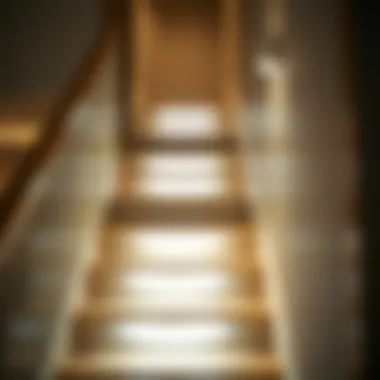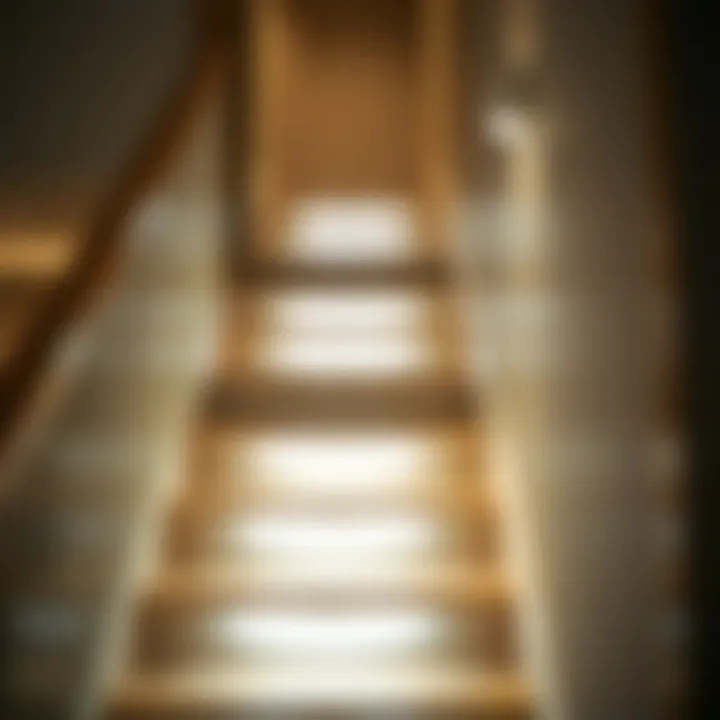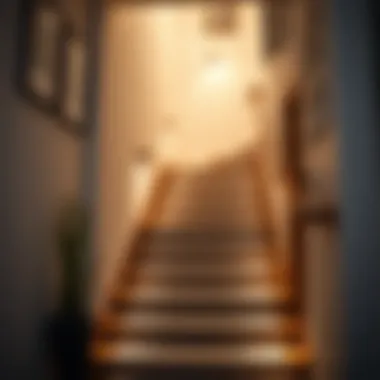Enhancing Home Safety with Motion Sensor Stair Lights


Intro
In modern home design, the integration of motion sensor indoor stair lights has become increasingly popular, bringing both safety and efficiency under one roof. Picture this: it’s late at night, and you need to navigate down a flight of stairs. With the flick of a switch—or rather, the silent detection of motion—the steps illuminate, guiding your path with soft, welcoming light. This technology enhances not just visibility but also peace of mind.
The relevance of motion sensor stair lights extends beyond mere convenience. They play a significant role in preventing accidents, particularly in households with older adults or young children. As we explore this fascinating topic, the focus will be on various essential facets. From understanding the underlying technology that powers these lights to selecting suitable designs for your home, each segment aims to equip homeowners and designers with knowledge to make informed decisions regarding this transformative fixture in residential spaces.
We will also touch upon installation considerations, energy consumption impacts, and maintenance routines, ensuring you’re well-prepared to embrace this innovative aspect of home safety. Throughout the discussion, we’ll aim for clarity and insight, enriching your understanding while keeping curiosity at the forefront.
Prelude to Motion Sensor Indoor Stair Lights
In the world of home safety and design, the significance of motion sensor indoor stair lights cannot be overstated. These innovative lights not only illuminate dark staircases but also contribute immensely to the overall safety of a home. With household injuries frequently occurring from slips and falls, particularly on staircases, it’s crucial to ensure these areas are adequately lit. Motion sensor lights serve as a proactive approach to preventing accidents. In other words, they act like vigilant guards, ready to spring to life as you approach, illuminating your steps and guiding you safely.
Furthermore, the benefits extend beyond mere safety. Motion sensor stair lights offer energy efficiency by activating only when needed. This technology helps in reducing electricity bills and makes a substantial difference in minimizing unnecessary energy consumption. Imagine climbing the stairs late at night, only for the lights to flick on as you reach the first step—a seamless experience that feels both intuitive and luxurious.
Considerations for choosing the right motion sensor lights go beyond functionality. Homeowners and designers alike should contemplate the aesthetics of these fixtures too. There is an array of designs available, each capable of blending with various interior styles—from modern minimalistic to rustic charm. This versatility means that these lights can not only serve a practical purpose but also enhance the visual appeal of a staircase.
Importantly, it’s not solely about the lights themselves; it’s about the technology that operates behind the scenes. Understanding how these motion sensors work—along with their different types—provides insight into choosing the best options for your space. A knowledgeable approach enables homeowners to make informed decisions that align with their specific needs, preferences, and budget.
In summary, as we navigate through this exploration of motion sensor indoor stair lights, we tap into a wealth of information that underscores their role in enhancing safety, efficiency, and aesthetic value in the home. Engaging with this topic reveals not just the technical details, but a more profound understanding of how integrated smart lighting solutions can help in creating a safer and more inviting environment.
The Importance of Stair Lighting
When it comes to designing a home, stair lighting may not often top the list of priorites, but it plays a pivotal role in both safety and aesthetic appeal. Proper stair lighting can be a game changer, transforming a sometimes neglected part of the home into a well-lit, inviting passage. Without a doubt, both the practical and visual impacts of stair lighting deserve attention.
Safety Considerations
One of the primary reasons to focus on stair lighting is safety. Stairs can be treacherous, especially in low-light conditions. Poorly lit stairs can lead to trips and falls, which can have serious consequences, especially for the elderly or young children. According to the National Safety Council, falls are among the leading causes of injury in households. Here’s where strategically placed motion sensor lights come into play—illuminating the way as someone approaches or descends the staircase.
- Highlighting Steps: Well-designed stair lights not only illuminate the walkway but also clearly define each step, reducing the chances of missteps.
- Automatic Activation: Motion sensors provide the convenience of lights turning on automatically, ensuring that no one has to fumble around in the dark.
- Minimized Hazard Risks: Installing these lights on staircases can be particularly significant in homes where visibility is limited due to architectural features or layout.
"Safe stairways are foundational to preventing falls. With motion sensor lighting, the risk drops significantly while comfort increases."
Aesthetic Appeal
While safety is paramount, the aesthetic potential of stair lighting cannot be overstated. The right lighting can enhance the overall ambiance of a home, blending functionality with style. Think of stair lighting as the proverbial icing on the cake—it not only serves a purpose but also adds to the visual delight of an interior space.
- Varied Designs: Motion sensor lights come in a myriad of designs, from sleek modern fixtures to more traditional options, offering choices that can complement the home’s decor.
- Creating a Mood: Dim lighting can create a warm, comforting atmosphere when used strategically, while bright lights can invigorate a space, depending on the desired effect.
- Highlighting Architectural Features: Well-placed lights can accentuate the beauty of the staircase itself, drawing attention to intricate railings or unique materials.
The integration of motion sensor indoor stair lights not only improves safety but also enriches the visual spaces within a home, making staircases an attractive feature rather than a forgotten corner. Homeowners and designers should carefully consider these elements to ensure that stair lighting is effectively utilized.
How Motion Sensors Work
Understanding how motion sensors operate is central to grasping their role in indoor stair lighting. These devices are designed to detect movement and trigger lights when needed, enhancing both safety and convenience in navigating staircases. They provide illumination only when someone is present, which not only aids visibility but also contributes to energy efficiency.
Basic Mechanisms of Motion Detection
Motion sensors primarily employ various technologies to detect movement. The basic idea involves identifying changes in the surrounding environment. For instance, passive infrared sensors detect heat emitted from objects, such as humans or pets, while ultrasonic sensors send out sound waves and measure their reflection to identify any movement.
The technology works much like your own senses; it's always watching and listening for changes. This leads to lights turning on just at the right moment, eliminating the need to fumble for switches in the dark. Ultimately, understanding these mechanisms can help homeowners select the best lighting options for their stairways.
Types of Motion Sensors
Different motion sensors offer distinct advantages, each suitable for various needs and environments. Here’s a brief overview of the most common types:
Passive Infrared Sensors
Passive infrared sensors (PIR) excel in detecting infrared radiation, commonly emitted by warm-bodied creatures like humans. This characteristic makes them quite popular for residential stair lighting. What makes PIR sensors stand out is their low power consumption and straightforward installation. They only activate when they sense a heat source, ensuring that lights only turn on when someone is present.
However, they do have some limitations. For example, if the target moves too quickly or if there are no heat differences, these sensors may fail to trigger. Yet, in most household settings, their benefits far outweigh the drawbacks, making them a go-to choice for many homeowners.
Ultrasonic Sensors
Ultrasonic sensors operate by emitting high-frequency sound waves that bounce back upon encountering an object, allowing them to detect motion over a wider area compared to PIR sensors. One key advantage of ultrasonic sensors is their ability to function well in varied environmental conditions; they aren’t as sensitive to heat differences as PIRs are.
However, a trade-off exists: they may sometimes register non-human movements, like the flutter of curtains or pet activity, leading to unnecessary light activation. Still, their high detection range makes them a suitable option for larger spaces or areas where multiple settings of movement are anticipated.
Dual Technology Sensors
Dual technology sensors combine the best of both worlds. By integrating functionality from both passive infrared and ultrasonic technologies, they significantly reduce the chances of false alarms common in single-mode sensors. This dual approach enhances reliability, as motion must be detected by both mechanisms for the light to activate.
While these sensors typically come at a higher price point, their ability to minimize energy waste and provide efficient lighting makes them a wise investment for stairways, ensuring safety without overloading homeowners with unnecessary light triggers.
"Investing in the right technology can turn every dark stair into a well-lit passage, keeping your home safe and efficient."
Benefits of Using Motion Sensor Lights
Understanding the benefits of motion sensor lights for indoor stairways is crucial for homeowners and designers alike. These lights not only amplify safety, but they also bring energy savings and increased functionality to residential spaces. As staircases can be a common site for mishaps, the integration of motion sensor technology here provides invisible support, ensuring that users can navigate their homes with confidence. Moreover, the energy efficiency advantages are significant; utilizing these sensors translates to reduced electrical consumption, ultimately leading to lower utility bills.


Enhanced Safety
Safety may well be the foremost advantage of employing motion sensor lights on stairs. These enhancements manifest as a simple yet effective precaution against accidents. If you’ve ever fumbled for a light switch in the dark, you know how unnerving it can be. Motion sensor lights illuminate the area just as you step into it, like a guiding light in the night.
Imagine a scenario where an elderly family member needs to use the stairs after dark; having lights that activate automatically minimizes the risk of falls. Beyond just preventing slips and trips, these lights can also provide reassurance; the soft glow greets you as you approach, rather than imposing a sudden, harsh lamp blare when hitting the switch. This aspect is particularly important in households with children or elders, where unexpected dimness can provoke alarm.
"Safety is not just the absence of danger, but the presence of light when you need it most."
Energy Efficiency
Besides safety, energy efficiency stands tall as another hallmark of motion sensor lights. Traditional lighting systems, whether incandescents or standard LEDs, can consume a lot of energy, especially when left on for long periods. On the flip side, motion sensors address this shortfall effectively. They switch on only when needed and switch off after a designated period of inactivity. This operational shift leads to substantial reductions in energy consumption.
Additionally, most modern motion sensor lights utilize LED technology, which is well-known for its longevity and low power usage. Compared to traditional bulbs, LEDs often last anywhere from 15 to 25 times longer, further enhancing savings on replacements.
Consider the following benefits of motion sensor lights in terms of energy efficiency:
- Automatic Shutoff: These lights can effectively reduce wasted energy during times when no one is around.
- Lower Bills: Users can observe a decrease in their monthly electricity expenses over time.
- Eco-Friendly: Utilizing less energy contributes to a smaller carbon footprint.
Design Options for Indoor Stair Lights
When it comes to enhancing safety and style in your home, the design of indoor stair lights holds significant importance. This isn’t just about illuminating the steps; it is about creating an ambiance that complements your overall home design. Picking the right type can remarkably improve not just safety but also the aesthetic appeal of your stairwell. Let's explore these distinct options, considering their benefits and practical applications.
Wall-Mounted Fixtures
Wall-mounted fixtures are the unsung heroes of stair lighting. Sturdily fixed to the wall, these lights can be easily positioned at various heights to ensure proper illumination of the staircase. The installation of wall-mounted fixtures often comes with two considerable benefits: they are space-saving and can present a clean, sophisticated look.
Also, you can choose from a variety of styles—modern sconce designs to traditional lanterns, ensuring that the lighting scheme can match the character of your home. Potentially, these lights serve a dual purpose, acting as decorative accents that add to the interior design while providing functional light. Pay attention to the brightness and color temperature; brighter, cooler lights can be more energizing, while warm lights create a more inviting atmosphere. For more details on lighting styles, refer to resources on design here.
Step Lights
Step lights are a practical approach to stairway illumination. These small fixtures installed directly into the risers of your stairs serve a vital purpose: guiding your steps safely, especially during the dark hours of the night. Their design allows them to blend seamlessly into the structure without being obtrusive, ensuring that the overall appearance of your staircase remains elegant.
Using LED step lights brings energy efficiency into the mix; they consume very little energy while providing adequate illumination. Look for adjustable brightness settings if you need different lighting levels for varying times of the day or activities. A well-placed step light can reduce the chances of accidents, making it a sound investment for families and elderly residents alike. For safety tips and examples of such applications, you may want to check resources like CDC.
Pendant Lights
Pendant lights add a touch of flair in areas where design takes precedence along with functionality. Hanging from the ceiling, these fixtures command attention and can be used to make a statement while also providing ample light. When positioning pendant lights above a stairway, consider both the height of the fixture and the size of the bulbs; you want to illuminate without dazzling.
They can be particularly beneficial in homes with high ceilings, where their height can enhance the overall spacious feeling of a room. As these lights often come in various styles—from sleek and modern to ornate vintage—you can choose one that resonates with your personal taste. Select an adjustable pendant so you can change the height as needed; this can bring versatility to your space. Explore more stunning lighting inspirations on platforms like Pinterest.
In summary, having multiple design options for indoor stair lights is not simply a matter of choice but also a pivotal factor in enhancing the usability and beauty of your home. Assessing factors such as space, style, and functionality allows you to make informed decisions that cater to your specific needs.
Installation Considerations
When it comes to installing motion sensor indoor stair lights, several factors must be pondered to ensure both functionality and safety. Effective installation is not just about placing a light in the right spot; it’s about strategizing the entire setup to maximize benefits while minimizing future headaches.
Optimal Placement
Choosing the right spot for your motion sensor lights is crucial. The key here is to position them where they can detect movement accurately while illuminating the stairs effectively. Consider a few pointers:
- Height Matters: Install sensors at a height of about six to eight feet; this prevents false triggers from pets or small children while still providing ample detection range for adults.
- Angles of Approach: Think about where people are likely to approach the stairs. Fitting lights at angles that can catch someone entering from either side is ideal. For instance, if your stairs are enclosed, positioning the lights on the sidewalls may not do the trick. You might need to get creative and use ceiling mounts that cast light downwards.
- Avoid Obstructions: Ensure that furniture or decor does not obstruct the motion sensors’ field of view. A light blocked by a plant or a staircase handrail will not function effectively.
By ensuring optimal placement, you not only enhance safety but also improve the overall effectiveness of your lighting system throughout the home.
Wiring and Power Supply
Once you've nailed down the placement, moving on to the wiring and power supply is the next big step. Here's what to consider:
- Professional Wiring: For most homeowners, unless you're comfortable with electrical work, it’s wise to enlist a professional. Incorrect wiring can lead to flickering lights or even worse, electrical failures. Make sure that the wiring matches the power requirements of your chosen sensors and bulbs.
- Power Source: Think about how you want to power the lights. Options include hard-wiring them into your home’s electrical system or using battery-operated lights, which tend to be more flexible.
- Consider Smart Features: If you’re integrating these lights into a smart home setup, make sure the wiring supports any additional tech such as WiFi connectivity or smart hubs. This will save time and likely lead to fewer outages in the long term.
- For hard-wired systems, ensure that the local electrical code is followed, and consider using LED lights for their energy efficiency and longevity.
- In the case of battery-operated options, take note of how often you’ll need to replace or recharge batteries. It’s a small hassle that can add up if your lights aren’t designed for prolonged use.
In summary, the installation phase is one where thoughtful planning and execution pay dividends. From how you wire the lights to the strategic placement of sensors, taking these installation considerations seriously ensures a safer, more enjoyable experience navigating your indoor stairs.
Choosing the Right Motion Sensor Indoor Stair Lights
Selecting the ideal motion sensor indoor stair lights is pivotal for striking a balance between functionality and aesthetics in your home. The right choice can vastly improve safety, convenience, and even energy efficiency, making life easier for you and your family. Moreover, making an informed selection not only safeguards against potential mishaps on the stairs but also enhances the overall ambiance of your living space. A well-lit staircase can be the difference between a serene evening at home and a stumble in the dark.
Assessing Your Needs
Before diving into specific products, it’s essential to consider your individual circumstances. Think about factors like:
- Staircase Design: Is it curved or straight? Does it have a landing? The design can play a significant role in where you install the lights and what type you choose.
- Frequency of Use: How often do the stairs get trafficked? If it’s a high-traffic area, you might prefer lights that are more durable and longer-lasting.
- Lighting Ambiance: Do you want bright, functional lighting, or a softer glow? Lighting sets the mood, so consider the atmosphere you aim to create.
Understanding your needs is half the battle. It will help guide your research and narrow down what features are most important to you. For instance, individuals with small children or elderly residents may prioritize features like brighter illumination and easy operation.
Comparing Brands and Models
Once you pin down what you need, it's all about making the right comparisons. With various brands and models flooding the market, doing due diligence now can save you headaches later. Here are some tips for making those comparisons:


- Read Consumer Reviews: Look up feedback on products from actual users. Websites and forums like Reddit and Facebook groups can provide valuable insights and reviews from real-life experiences.
- Check Specifications: Not every motion sensor is created equal. Examine the specifics, such as detection range, response time, and adjustability of the sensor settings. You want a model that adapts to your needs, rather than forces you to fit into its limitations.
- Consider Energy Efficiency: If saving on electricity is a priority, look for lights that offer LED technology or have energy-saving modes. Often, the cost over time can outweigh any initial savings found in cheaper models.
- Warranty and Support: Look for brands that offer a solid warranty and customer support. This is particularly crucial if you encounter any issues with installation or operation down the line.
When comparing your options, don’t shy away from digging deep into product specifications or reaching out to retailers for more information. The more you know, the better equipped you'll be to make a choice that fits seamlessly into your home and lifestyle.
Maintenance and Care
Proper maintenance and care of motion sensor indoor stair lights is essential for their longevity and optimal performance. Like any other home fixture, these lights require a bit of attention to ensure they continue to function effectively and efficiently. Neglecting to maintain them can lead to various issues, including reduced brightness, malfunctioning sensors, and premature deterioration of components. Regular upkeep can prevent these problems and also enhance the safety of your home, particularly in stair areas where right illumination is crucial.
Regular Checks and Cleanings
Regular checks and cleanings should be part of your routine to ensure your motion sensor lights are in tip-top shape. Dust and debris can easily accumulate on the fixtures, causing the sensors to become less sensitive and the lights dimmer. This is particularly relevant in homes with pets or high foot traffic.
- Here are some straightforward steps for keeping your lights sparkling and functioning:
- Dusting: Use a soft cloth or microfiber duster to gently wipe the exterior of the fixtures. If you notice any noticeable grime, a damp cloth with a bit of dish soap can work wonders.
- Lens Cleaning: The sensor lens may require more care. A simple glass cleaner can help dislodge any smudges or dirt buildup that can interfere with detection.
- Check for Obstructions: Ensure that there are no objects nearby blocking the sensor’s field of detection. Placement matters, and even furniture can impair the effectiveness.
Keeping up with these simple tasks every month can greatly increase the lifespan of your fixtures, making sure your stairs are well-lit at all times.
Troubleshooting Common Issues
Sometimes, despite your best efforts at maintenance, issues can still arise with motion sensor stair lights. By being prepared to troubleshoot common problems, you can save yourself a fair bit of hassle.
*
- False Triggers: If your lights are turning on unexpectedly, it could be due to environmental factors. Trees moving in the wind or passing vehicles can sometimes fool the sensor.
- Lights Not Activating: If the lights refuse to activate, check if the power source is intact. Also, look for any potential damage to wiring.
- Dimming Over Time: If the brightness fades, it could mean the bulbs are nearing the end of their lifespan. Replacing them can restore the intended luminosity.
Keep in mind that if you encounter persistent issues, consulting the user manual or contacting the manufacturer can provide more specific guidance. A few simple troubleshooting steps at the first sign of trouble can save you from complete replacements, ensuring you stay safe and illuminated in your home.
Impact on Energy Consumption
Understanding the impact of motion sensor indoor stair lights on energy consumption is crucial for homeowners looking to enhance their living spaces while being mindful of their energy usage. These lighting solutions not only brighten up often-neglected areas like staircases but also contribute significantly to reducing electricity bills. By incorporating motion sensors, these lights activate only when necessary—offering efficiency that traditional lighting systems cannot match.
The potential for energy savings hinges on several factors including the type of sensors used, the duration of illumination, and how they interact with other lighting systems in the home. Integrating motion sensor lights into stairways can significantly mitigate wasted energy, leading to a more sustainable and cost-effective home environment.
How Motion Sensors Contribute to Energy Savings
One of the primary advantages of motion sensor lights is their ability to stay off until movement is detected. This capability is particularly handy in areas such as staircases where lights are often left on unnecessarily. Here are some key points about their energy-saving benefits:
- Automatic Activation: Motion sensors eliminate the need to remember to turn stair lights on and off, reducing energy wastage. They trigger lights only when someone approaches, ensuring lights are not left burning when not needed.
- Adjustable Settings: Many modern motion sensors come with adjustable timers that determine how long the light stays on after activation. This feature can be tailored to suit individual needs, further optimizing energy use.
- LED Compatibility: Most motion sensor stair lights are compatible with LED technology. LEDs consume a fraction of the energy traditional bulbs do, providing longer life and less frequent replacements. This combination maximizes energy savings over time.
"In today’s eco-conscious world, energy efficiency isn't just an option; it's a necessity. Motion sensor lights embody this, saving energy without sacrificing safety or comfort."
Comparing Costs Over Time
When it comes to home lighting, starting costs often loom large in decision-making. However, evaluating the long-term financial impact can show a very different picture. Consider the following:
- Initial Costs vs. Long-Term Savings: While the initial price of motion sensor lights might be higher than standard lighting options, those costs can often be recuperated through lower energy bills. It's important to look beyond the sticker price.
- Consumer Behavior: Homeowners who install motion sensor lights often find themselves changing behavior as well. Less reliance on lighting for navigational purposes sends these users toward lower energy usage over time.
- Overall Maintenance Costs: In addition to energy savings, these systems generally require less maintenance. With LEDs typically lasting up to 25,000 hours, the frequency of bulb replacements drops dramatically.
- Investment in Safety: The financial benefits of these lights also intertwine with safety—preventing accidents or injuries from walking in the dark. This not only reduces healthcare costs but also may lead to lower home insurance premiums.
Future of Motion Sensor Technology
The realm of motion sensor technology is rapidly evolving, significantly impacting how we think about safety and efficiency in our homes. As we navigate through modern living spaces, we find ourselves integrating innovation into every corner of our daily lives. Motion sensor indoor stair lights are at the forefront of this technological shift, promising enhanced user experience through reliable and intelligent performance.
Understanding the future of this technology is essential for homeowners, designers, and DIY enthusiasts. The upcoming advancements not only promise improved functionality but also a seamless integration of design with efficiency. The shift toward smarter, more responsive lighting solutions reflects a broader trend in home automation, where convenience meets safety.
Advancements in Sensor Technology
The landscape of sensor technology is poised for groundbreaking changes. The key advancements include:
- Enhanced Detection Capabilities: New sensors are becoming more sensitive and accurate, reducing false triggers but still responding promptly to genuine movement. This evolution addresses common complaints that users have had, particularly concerning light activation caused by pets or passing vehicles.
- Smart Algorithms: Modern motion sensors now often incorporate smart algorithms that learn from user behavior over time. These adjustments can personalize the light intensity and duration, fine-tuning the user experience. For instance, a light might initially turn on brightly when you first enter a space and then adjust to a lower brightness after several seconds, based on learned patterns.
- Longer Lifespan and Reliability: Improvements in materials and manufacturing processes lead to sensors that last longer and require minimal maintenance, ensuring lasting performance.
"Technological advancements in motion sensors are not just about connectivity. They are about understanding the user's needs and environment."
Integration with Smart Home Systems
Linking motion sensor stair lights with smart home systems augments their value dramatically. This integration manifests through various technologies and networking capabilities, including:
- Control through Mobile Apps: Many modern systems now offer apps that allow users to control their lights remotely. This feature enhances flexibility, allowing individuals to manage stair lighting settings from anywhere in the home.
- Voice Activation: With the rise of virtual assistants like Amazon Alexa and Google Assistant, the ability to control lights via voice commands is no longer a novelty but an expectation. This hands-free option is particularly useful for individuals carrying items up or down stairs, ensuring both convenience and safety.
- Automation and Scheduling: Users can set up routines that turn lights on at certain times or in response to other smart devices — for instance, lights turning on when a door is opened. Integration with smart security systems can also prompt stair lights to illuminate when motion is detected outside.
In summary, the future of motion sensor indoor stair lights is intricately tied to the advancements in sensor technology and smart home integrations. Understanding these elements can aid homeowners in making informed decisions, keeping their living spaces safe and stylish as technologies bloom.
Case Studies: Successful Implementations
In the realm of motion sensor indoor stair lights, examining real-world applications can provide invaluable insights into both their effectiveness and versatility. Case studies demonstrate how these lights can be tailored to various environments, illustrating their benefits in enhancing safety, aesthetics, and energy efficiency. By reviewing specific examples, homeowners and decorators can glean ideas and strategies for integrating motion sensor lights into their own spaces.
Residential Applications
Homeowners often find themselves grappling with the challenge of illuminating staircases safely. A notable case study involves a family residence in Seattle, where spiral staircases posed a typical risk of accidents at night. The homeowners decided to install motion sensor lights embedded beneath the handrail.
These sensors activate when someone approaches the stairs, providing soft illumination that guides both adults and children safely down. Thanks to this enhancement, nighttime trips to the bathroom or kitchen no longer turned into treacherous missions. The lights also switch off automatically after a few minutes of inactivity, which helps conserve energy.


Another effective example can be found in a split-level home in the suburbs of Chicago. The owners opted for wall-mounted motion sensor lights alongside their staircase that feature a sleek and subtle design. The activation range was adjusted to align perfectly with the stair dimensions, easing concerns about false triggers due to passersby. This implementation significantly reduced climbing accidents and added a layer of modern elegance to their home.
- Benefits observed:
- Increased safety during nights
- Reduced energy waste due to automatic turn-off
- Modern aesthetic enhancement of living space
Commercial Spaces
In commercial contexts, effective lighting is crucial not only for safety but also for compliance with legal standards. Consider a case study at a renovated office building in New York City that features an extensive and intricate staircase system. To meet both safety and energy efficiency goals, the building management decided to implement motion sensor lights alongside the stairways.
These sensors were strategically placed to ensure optimal coverage, lighting up upon detecting movement during office hours and after hours alike. They chose LED fixtures, which not only contribute to significant energy savings but also align with sustainability initiatives. The result was a safer environment that adheres to building codes regarding emergency exits, while also emphasizing the elegance of the architectural design.
Furthermore, a popular restaurant chain adopted motion-sensitive floor lights leading to their cellar storage area. Given the heavy foot traffic, these lights offer immediate illumination, ensuring staff can navigate safely to and from storage without fumbling in the dark. This approach not only mitigated workplace accidents but also enhanced the overall dining experience by ensuring staff visibility.
- Benefits observed:
- Compliance with safety regulations
- Enhanced visibility in high-traffic areas
- Support for energy-saving initiatives
"Case studies illustrate the practical benefits of motion sensor indoor stair lights, allowing homeowners and businesses to make informed choices, paving the way for a safer and more efficient environment."
By examining these successful implementations, it becomes clear that motion sensor indoor stair lights are not merely a form of light; they are an essential component in modern safety and energy strategies for residential and commercial spaces alike.
Common Misconceptions About Motion Sensor Lights
Motion sensor indoor stair lights have gained traction in homes for their practicality and safety benefits. Yet, several misconceptions still circulate about their usage and functionality. Understanding these myths is crucial for homeowners, decorators, and DIY enthusiasts alike, as it can significantly impact the decision to integrate these lights into residential spaces.
Light Sensitivity Issues
One common belief is that motion sensors can be overly sensitive to light, leading to unintentional activations during the day when natural light fills the space. In reality, most modern motion sensors are designed with adaptability in mind. They typically come equipped with a light sensor that disables the motion detection function during daylight hours.
Take for instance, the Philips Hue Motion Sensor. This device cleverly adjusts its functionality based on the ambient light, ensuring it only activates its lighting features when required. This implies that a well-placed motion sensor can substantially reduce false triggers and the light’s unnecessary illumination.
However, placement is key; installing them too close to windows can indeed cause light sensitivity issues. To counteract this, place sensors away from direct sunlight or install them in shaded areas to improve performance.
"Understanding the mechanics behind motion sensor placement is half the battle; the other half lies in choosing the right product that suits your lighting needs."
Overreaction to Movement Detectors
Another prevalent misconception is that motion sensors are prone to overreacting to movements. People often fear that anything from a pet to a floating balloon would trigger the lights, making them unreliable. The truth is, various types of sensors exist, each with unique detection methods and capabilities.
For example, Passive Infrared (PIR) Sensors detect heat emitted by objects. As such, they are less likely to respond to small movements or disturbances without significant temperature changes. This means that while a small cat might set off traditional sensors, newer models with improved intelligence can distinguish between people and pets based on the heat signature.
Moreover, some models are equipped with technology that can differentiate human movement from other motions, an essential feature for noise-sensitive spaces. This intelligence helps mitigate unnecessary light activations and makes the use of motion sensors more effective in high-traffic areas of the home like staircases.
Help Sections about Motion Sensor Indoor Stair Lights
Understanding the fundamental questions about motion sensor indoor stair lights is crucial for anyone considering their installation. By answering key concerns, home and property owners can navigate the vast marketplace of lighting options with confidence. From clarity on brands to the functionality of these lights, evaluating these aspects can help ensure that buyers make informed choices tailored to their specific needs.
What are the best brands?
When it comes to choosing the right motion sensor indoor stair lights, the brand often speaks volumes about quality and reliability. Some of the more reputable names in the industry include Philips, Lutron, and Mr. Beams.
- Philips: Known for its innovative technology, Philips offers a range of products that combine longevity with modern design.
- Lutron: Specializing in smart home solutions, Lutron provides options that can easily integrate into existing systems, making them a chic choice for tech-savvy homeowners.
- Mr. Beams: A go-to for battery-operated lights, Mr. Beams products are often recommended for their simplicity and ease of setup, ideal for DIYers.
Each brand has its unique set of features and benefits. Investigating customer reviews and conducting hands-on research will go a long way in helping potential buyers discern what products suit their needs best.
How long do the lights last?
The longevity of motion sensor lights varies significantly based on the type you choose and your usage patterns. Generally, LED bulbs dominate this category, offering impressive lifespans ranging from 15,000 to 50,000 hours. This translates to years of reliable lighting if used judiciously.
However, it's essential to factor in the sensor's efficiency. Some motion sensors can lead to wear and tear, especially in environments with frequent foot traffic. A good rule of thumb is to continuously monitor the performance; if the lights start flickering or exhibit delayed responses, it may be time for a replacement.
Can use them outdoors?
Jointly, most motion sensor lights designed for indoor use may not functionally suit outdoor settings. They typically lack the necessary weatherproofing and durability to withstand the elements. For outdoor applications, it’s advisable to opt for models specifically engineered to be resistant to moisture and temperature fluctuations.
However, certain brands, like Ring and Leviton, have diversified their offerings to include outdoor-rated motion sensor lights, providing a seamless transition for those looking to light up both interiors and exteriors.
Epilogue
In wrapping up our discussions on motion sensor indoor stair lights, it’s vital to recognize their multifaceted importance within our home environments. Beyond mere convenience, these lights critically enhance safety by preventing trips and falls, a consideration that can’t be overstated, especially in households with young children or elderly residents.
Key Benefits of Motion Sensor Indoor Stair Lights:
- Increased Safety: Lights that activate automatically when motion is detected provide the illumination needed to navigate stairs without stumbling. This can dramatically reduce accidents and serious injuries.
- Energy Efficiency: Traditional lights often demand manual operation, leading to unnecessary power usage. Motion sensors, however, ensure that lights only function when needed, thereby cutting down on energy costs and extending bulb lifespan.
- Ease of Use: For those carrying items or those with mobility issues, the hands-free operation of motion sensor lights can be a real game changer.
In addition to these benefits, it’s crucial to consider factors like design, placement, and maintenance. Homeowners must choose fixtures that not only suit their visual aesthetics but also fit the specific architectures of their staircases. Ignoring the right fit can result in lighting that fails to serve its primary purpose—casting light where it’s needed most.
Furthermore, regular maintenance, such as cleaning the sensor lenses, ensures the system’s longevity and efficiency. A diligent approach to upkeep can save one from unexpected dark patches that could lead to accidents.
"When the lights don’t work as they should, even the best systems can feel like a disappointment."
As we look towards the future, advancements in technology promise even smarter solutions integrated with other systems in smart homes. Homeowners will want to remain informed on such innovations, ensuring they use the latest technology to enhance their safety and comfort.
Ultimately, selecting the right motion sensor indoor stair lights involves a blend of personal preference and practical considerations. By giving careful thought to these details, homeowners and designers can create a safe and welcoming environment tailored to the needs of all who pass through their spaces.







